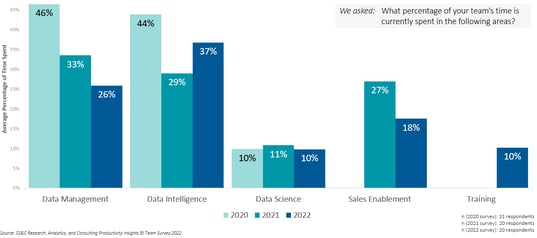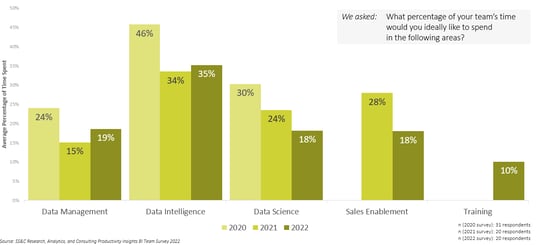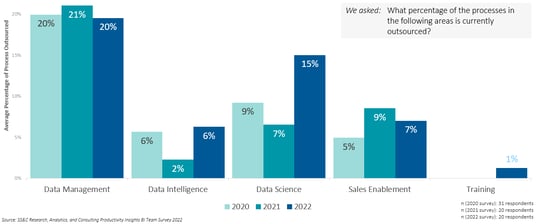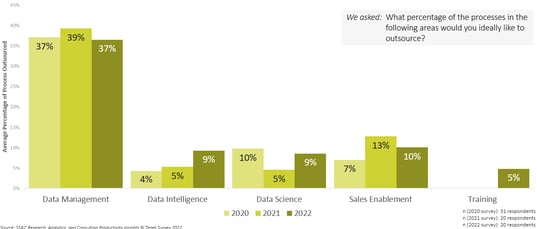BLOG. 4 min read
How Should Your Business Intelligence Team Spend Their Time?
July 22, 2022 by Sarah Mahmoud, CFA
Having a Business Intelligence (BI) team was once considered an added bonus at “forward-thinking,” large asset management firms. This is firmly no longer the case; a BI function is now essential at firms of all sizes, due in no small part to the existence and availability of numerous data types and sources. In a recent BI survey of 23 asset management firms, 100% of responding firms had a BI/Data Intelligence function. While this is not surprising, the role and positioning of these functions differ significantly across firms.
In its most basic form, a BI team is a data management function to manage and integrate (to varying degrees) all internal and external sources of data the firm receives. In firms with a more basic BI function, it is used as a reporting resource to track KPIs and sales activity for compensation and sales team feedback. It often also answers questions from the sales team and senior leadership.
Moving towards the more advanced side of the spectrum, a BI function is more focused on data intelligence than data management. Developed teams have invested in and built the necessary infrastructure (and/or third-party relationships) to both manage their firms’ internal data and import and integrate third-party data. As a result, less time is spent on managing, cleansing, formatting, and/or manually integrating data. Instead, their focus is on extracting insights from said data to inform business decisions across the firm.
Business Intelligence Team Time Allocation
As noted in the following chart, the average time spent on data management vs. data intelligence has decreased in recent years as firms placed higher importance on investing in and using data and building out their business intelligence teams and capabilities. This trend was evident 3-4 years ago but was accelerated by the remote environment in 2020-2021 when firms found themselves more reliant on data to inform and drive sales activity in the absence of in-person meetings. In 2022, an average of 26% of a BI team’s time is spent on data management compared with 46% in 2020.
Current Allocation of Time: Average %

Extending the question of how much time would be allocated in an ideal scenario, we see that firms aim to reduce time spent on data management even further to less than 20% (see the following chart). The additional bandwidth will be spent on Data Science—an emerging area in BI teams.
Ideal Allocation of Time: Average %

Business Intelligence Outsourced Activities
It is no surprise that the trend is shifting to spending more time on areas that directly benefit the business. Considerable effort is needed to join data from different sources to be able to use them cohesively. Because it is time-consuming and yields little results without the proper analysis, data management has historically been the area most outsourced to external providers (~20% of data management activity).
Proportion of functions Currently Outsourced: Average %

However, when we look at the ideal percentage of data management that BI teams think should be outsourced, we see that it is almost double. Seeing as the ideal level of outsourced data management is at 37% and the current level is at 20%, we would expect the current level to increase over the years. This has not been the case. Instead, both have plateaued at the same levels indicating a persistent gap between the current and ideal levels of outsourcing. This is surprising given that outsourced approaches can often be more cost-effective.
And while third parties can absolutely help to deliver insights, it is not all that surprising that firms aim to ideally outsource relatively less of their data intelligence, data science, and sales enablement activities than they do of their data management activities. These areas are where the real value added lies. This is where the BI team arrives at actionable insights to drive business activity within the national sales, national accounts, marketing and product teams. Our survey data shows that BI teams are currently outsourcing more of their data science activities (15%) than they would like (9%). We would expect that as larger BI teams build out their data science capabilities, more of this function will be brought back in-house, whereas smaller firms are likely to continue to rely on external partners.
Proportion of functions Ideally Outsourced: Average %

While the function of BI teams differs across firms, they have a common end goal: to provide insights derived from data to drive business decisions. With ever-increasing sources and amounts of data, human and technological resources available within the firm remain finite. It is imperative that you achieve the most efficient combination of outsourcing those activities that take the most time with minimal benefits and spending your time on activities that add the most value to your firm.
SS&C’s Distribution Solutions team can help asset management firms evaluate and optimize their Business Intelligence capabilities, and contact us to learn more about current approaches.
Written by Sarah Mahmoud, CFA
Managing Consultant, Research, Analytics and Consulting



.jpg)
.jpg)

